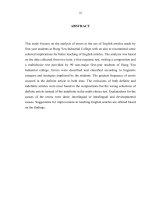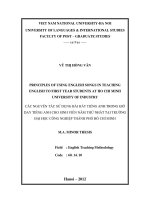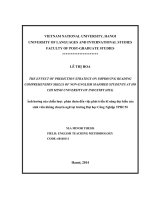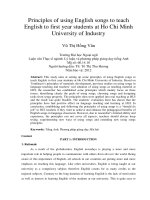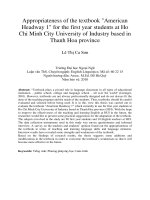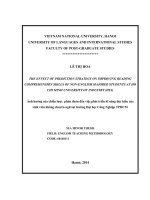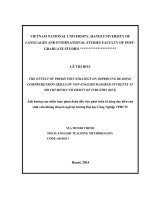Principles of using English songs in teaching English to first year students at Ho Chi Minh University of industry = Các nguyên tắc sử dụng bài hát tiếng Anh tr
Bạn đang xem bản rút gọn của tài liệu. Xem và tải ngay bản đầy đủ của tài liệu tại đây (616.5 KB, 55 trang )
VIET NAM NATIONAL UNIVERSITY-HA NOI
UNIVERSITY OF LANGUAGES & INTERNATIONAL STUDIES
FACULTY OF POST – GRADUATE STUDIES
VŨ THỊ HỒNG VÂN
PRINCIPLES OF USING ENGLISH SONGS IN TEACHING
ENGLISH TO FIRST YEAR STUDENTS AT HO CHI MINH
UNIVERSITY OF INDUSTRY
CÁC NGUYÊN TẮC SỬ DỤNG BÀI HÁT TIẾNG ANH TRONG GIỜ
DẠY TIẾNG ANH CHO SINH VIÊN NĂM THỨ NHẤT TẠI TRƯỜNG
ĐẠI HỌC CÔNG NGHIỆP THÀNH PHỐ HỒ CHÍ MINH
M.A. MINOR THESIS
Field : English Teaching Methodology
Code : 60. 14. 10
Hanoi – 2012
VIET NAM NATIONAL UNIVERSITY-HA NOI
UNIVERSITY OF LANGUAGES & INTERNATIONAL STUDIES
FACULTY OF POST – GRADUATE STUDIES
VŨ THỊ HỒNG VÂN
PRINCIPLES OF USING ENGLISH SONGS IN TEACHING
ENGLISH TO FIRST YEAR STUDENTS AT HO CHI MINH
UNIVERSITY OF INDUSTRY
CÁC NGUYÊN TẮC SỬ DỤNG BÀI HÁT TIẾNG ANH TRONG GIỜ
DẠY TIẾNG ANH CHO SINH VIÊN NĂM THỨ NHẤT TẠI TRƯỜNG
ĐẠI HỌC CÔNG NGHIỆP THÀNH PHỐ HỒ CHÍ MINH
M.A. MINOR THESIS
Field : English Teaching Methodology
Code : 60. 14. 10
Supervisor : Dr. Tô Thị Thu Hương
Hanoi – 2012
iv
TABLE OF CONTENT
DECLARATION 1
ACKNOWLEDGEMENTS 1
ABSTRACT iii
TABLE OF CONTENT iv
LIST OF CHARTS AND TABLES vii
PART A: INTRODUCTION 1
1. Rationale 1
2. Aims of the study 3
3. Scope of the study 3
4. Method of the study 3
5. Design of the study 4
PART B: DEVELOPMENT 5
CHAPTER 1: LITERATURE REVIEW 5
1. Reasons why English songs should be used as teaching materials. 5
2. Materials in foreign language learning and teaching 7
3. Principles of developing teaching materials 7
3.1. Materials should achieve impact 8
3.2. Learner’s attention should be drawn to linguistic features of the input. 8
3.3. Materials should provide the learners with opportunities to use the target
language to achieve communicative purposes. 8
3.4. What is being taught should be perceived by learners as relevant and
useful. 9
3.5. Materials should take into account that learners differ in learning style and
affective attitude 9
3.6. Materials should help learner feel at ease and develop confidence 10
4. Previous studies on using songs to teach English 11
4.1. Teaching grammar 11
4.2. Teaching Vocabulary 13
4.3. Teaching Pronunciation 13
4.4. Teaching listening 14
v
4.5. Teaching speaking, writing and reading 16
CHAPTER 2: A STUDY ON USING SONGS AS TEACHING MATERIAL IN
TEACHING ENGLISH TO FIRST YEAR SUTDENTS AT HUI AND
SUGGESTED PRINCIPLES OF USING SONGS TO TEACH ENGLISH 17
1. Research approach and questions 17
2. Participants 17
3. Data collection instrument 18
4. Procedures of data collection 18
5. Data analysis 18
6. Results of data analysis 19
7. Discussion 23
8. Suggested principles of using songs in teaching English 24
CHAPTER 3: PRINCIPLES OF USING SONGS IN TEACHING ENGISH TO
FIRST YEAR STUDENTS AT HUI: AN APPLICATION AND EVALUATION 32
1. Putting the principles into use: teaching English to first year students at HUI 32
1.1. Some description of the pilot classes 32
1.2. Procedure 33
1.3. The application of the principles of using songs 33
2. A SAMPLE LESSON PLAN 34
3. Evaluation of the feasibility and suitability of the proposed principles in
teachingEnglish at HUI 36
3.1. Procedure and data collection instrument 36
3.2. Data analysis and discussion 37
PART C: CONCLUSION 40
1. Summary Error! Bookmark not defined.
2. Limitation of the study 41
3. Suggestions for further study 41
REFERENCES 41
APPENDIX 1 VII
APPENDIX 2 IX
APPENDIX 3 X
vi
LIST OF CHARTS AND TABLES
Pie chart 1: The usefulness of English songs in language teaching
Pie chart 2: The frequency of using English songs in language classroom
Pie chart 3: The effect of teaching English with songs on students‟ language
proficiency
Pie chart 4: The effect of using English songs on students‟ learning motivation
Pie chart 5: The degree of language improvement thanks to the use of English
songs
Table 1: Aims of using songs in language classroom
Table 2: Activities with songs
Table 3: Difficulties when using songs to teach English
Table 4: Language components and skills improved thanks to the use of English
songs
1
PART A: INTRODUCTION
1. Rationale
As a result of the globalization, English nowadays is playing a more and
more important role in helping people to communicate with others from all over
the world. As the common language of the whole world, English is an essential
requirement for those who want to study abroad, work in a foreign country or
company, or even to find a good job in local companies. English is also the key for
our country to integrate into the world and to catch up with developed countries in
terms of economy, education, science and technology. Being aware of this
importance of English, all schools in our countries are putting more and more
emphasis on teaching this language. Like other universities, English is being
taught at our university as a compulsory subject; therefore English counts for as
many credits as the majored subjects. Right when entering the university,
freshmen are required to take a placement test to classify the level of English, and
then they will be placed in different classes according to their English level,
namely A1, A2, basic English 1, basic English 2. Among those, A1 and A2 take
90 periods for each class, basic English 1 takes 60 periods and basic English 2
counts for 45 periods. For students whose result at the placement test is below
mark 5 will have to study from the lowest level - A1. This means they have to
study at least 285 periods. Contrary to the long duration of learning English is the
lack of motivation as well as interest in learning English of the students at our
university. This is quite easy to understand because most of the students at our
university are non-majored English students. Their English proficiency is quite
low as a result of the passive, test-oriented learning style at their high school that
is just focusing on the main subjects taken in the entrance examination to the
university. In addition, teaching and learning method is also a cause of the
students‟ demotivation of learning English. Regarding the teaching methods, most
of the English teachers still keep the traditional teaching approach which focuses
on grammar and translation. Not many communicative activities are organized in
2
class. The traditional class – teacher centered still remains, hence students just sit
silently and listen to teachers. The English lessons are said to be boring, tiring and
sometimes even tense. Being aware of this negative learning and teaching
condition, many teachers in our university are trying to change their teaching
method by integrating different teaching approaches and using more interesting
teaching aids such as pictures, flashcards, PowerPoint, games, stories and songs.
Among those, songs seem to be the most popular to students and also more
frequently used by teachers than others. However, the effectiveness gained
through using songs is still not high as expected. Although songs have been
proved to be a very interesting teaching materials and have been applied in
teaching in many European countries, this method still seems to be a new one for
Vietnamese teachers in general and the teachers at Ho Chi Minh University of
Industry (HUI) in particular. Most teachers still meet difficulties in working out
the way to exploit the maximum benefits of songs in English classroom. It seems
that teachers just spontaneously use English songs as an entertaining tool to relax
students not a teaching aid. Teachers fail to set a particular pedagogical aim or
follow a specific rule of using songs. Generally, songs are often played at the end
of the lesson when teaching and learning is finished and students are sitting to wait
for the bell rang. Sometimes teachers also let students listen to English songs at
break time; hence not all students pay attention to the songs. Sometimes songs are
also put in the course books as an extra task such as listen to the song and fill in
the blanks. However, teachers tend to have different ways of carrying out this task.
While some teachers ignore this task and just let students sit and enjoy the music,
other explain the instruction and let students listen to the song, get them to finish
the task and then check as an exercise. They rarely explain what students can learn
from the songs or have no further activities or tasks for the students after having
students listened to music. Therefore students often forget the song right after
listening or even if they are interested in the song, they do not know what to do
with it. In short, for most of the students at my university, they just regard songs as
3
a means of entertainment not a useful tool/source of learning English. For
teachers, most of them have not succeeded in exploiting the pedagogical benefits
of English songs except for the entertaining and relaxing benefits. As a teacher of
English at the university, I am also very interested in using songs as a teaching aid
in English lessons. Learning that at present, songs are not effectively used in
teaching English at HUI, I myself realize that in order to get optimal benefits from
using English songs as a teaching tool, there should be some principles of using
songs to teach English to guide teachers.
2. Aims of the study
The study aims at helping teachers to exploit the pedagogical benefits of English
songs to teach English at HUI. To achieve this aim, the research is designed to
obtain the two following objectives:
(1) setting out the principles of using English songs to teach English to first
year HUI students through empirical research, i.e. HUI English teacher survey
and student evaluation;
(2) finding out the feasibility of applying these suggested principles of
using songs to teach English to first year students.
3. Scope of the study
The study mainly focuses on finding out the principles of using songs to teach
English to first year students at Ho Chi Minh University of Industry. It, therefore,
does not focus on exploring the effectiveness of the principle application.
4. Method of the study
The study followed qualitative approach and used mixed methods to collect data.
The following data collection instruments were used:
1. Teachers‟ questionnaire
2. Evaluation questionnaire for students
The questionnaire was designed for 20 English teachers from the Basic
Science and Technology Department at Ho Chi Minh University of Industry. The
evaluation form was designed to elicit the evaluation from 100 first year students
4
at HUI who had involved in the English classes with the teachers applying the
principles to use songs to teach English. The data collection process lasted 2
weeks (teacher questionnaire) and in the last week (student evaluation) during the
first term of the academic year 2012- 2013.
5. Design of the study
This study contains three main parts as follow:
Part A is the introduction in which I would like a present the rationale of
choosing this topic, the aim of the study, the scope of the study and the
methods to be applied.
Part B is the development which includes three main chapters:
Chapter 1 is about the theoretical background related to the purpose
of the study
Chapter 2 deals with investigating the situation of using English
songs in teaching at HUI and finding out the principles of using
songs to teach English for first year students at Ho Chi Minh
University of Industry
Chapter 3 is concerned with applying the proposed principles of
using songs in teaching English at HUI and then evaluating the
feasibility of these principles when applied in real teaching at HUI.
Part C is the summary of the major findings in Part 2 and suggestions for
further study. This part also contains the List of References and Appendices.
5
PART B: DEVELOPMENT
CHAPTER 1: LITERATURE REVIEW
1. Reasons why English songs should be used as teaching materials.
According to Larry M. Lynch (2005), there are 9 reasons why songs are
used to teach English as a foreign language such as the authentic and natural
language, easily controlled time length and easy obtainment. Besides, learning
with songs students can have the chance to learn a variety of vocabulary contained
in the songs and be exposed to many different accents as well as different cultures.
Moreover, songs are considered to be fun and easily meet the need as well as
interest of the students.
Kevin Schoepp (2001) discusses the reasons that make songs become a
useful tool of teaching English by compiling other researchers‟ point of view on
this issue. Three main reasons are:
Affective reason
Sharing the same point of view with Larry M. Lynch on the matter that
songs make students feel fun and interested, Steven Krashen (1982) gives out a
deeper explanation based on his own hypothesis called The Affective Filter
Hypothesis. Basically Krashen‟s hypothesis explains how language learning is
affected by affective factors. This helps teachers understand why some students
are interested in learning while others are not. Not only Krashen but also many
other teachers have long recognized that learner‟s positive attitude toward learning
decide how much learners can improve their language proficiency. Krashen (1982)
explains that for optimal learning to occur the affective filter must be weak. This
hypothesis gives teachers a suggestion that they should provide a positive
atmosphere conductive to language teaching. Songs are one tool to achieve a weak
affective filter and promote language learning. Supporting for this idea, Lo and Li
(1998) add that songs can blow into classroom a refresh and relaxing atmosphere
in which learners can develop their language skills.
6
The belief that songs provide enjoyment and develop language skills comes
from several other authors (Adamowski, 1997; Bechtold, 1983; Domoney &
Harris, 1993; Griffee, 1992; Guglielmino, 1986; Lems, 1984; Little, 1983;
Monreal, 1982). The enjoyment of learning language through song is directly
related to affective factors.
Cognitive Reasons
It‟s widely known that automaticity in language learning is one of the
factors that help learners become fluent communicator. Accroding to Gatbonton
and Segalowitz (1988, p.473) atumomaticity is “a component of language fluency
which involves both knowing what to say and producing language rapidly without
pauses”. Kevin Schoepp (2001) confirms that the main cognitive reason for using
songs as teaching material is that songs can enhance learner‟s automaticity. This is
understandable because automaticity is traditionally believed to occur through
repetition. The nature of songs is fairly repetitive and consistent and, therefore,
helps facilitate language learning as well. For example, a song such as “Lemon
tree” – a very famous pop song provides sample opportunities for students to focus
on the study of the present progressive in English Grammar with the lyrics
containing a lot of sentences in the present continuous.
Linguistic Reasons
In Kevin Schoepp‟s opinion, linguistic factor is also a reason that teachers
use songs in the classroom. By using songs, learners can be exposed to the
informal or colloquial language which is often met in real life. Some songs are
excellent examples of colloquial English. Let‟s take the song "My Best Was Never
Good Enough" by Bruce Springsteen as an example. This song is a prime example
of a song that demonstrates colloquial language use. Students will hear many
colloquial sentences such as "Every cloud has a silver lining." and "Every dog has
7
his day” in this song. Hence, using songs can prepare students for the genuine
language they will be faced with.
Finally, two studies, Domoney and Harris (1993) and Little (1983) once
again confirm the importance of music to language learning. These two authors
both found out that pop music exist apparently in the lives of EFL students and
music is the major source of English outside the classroom. The frequent use of
English songs in classroom can enhance automaticity and positive affective filter.
If students are exposed to songs which they enjoy, more learning is likely to occur
since they may seek out the music outside of the classroom. The repetition feature
of songs then helps to promote automaticity of colloquial language.
2. Materials in foreign language learning and teaching
According to Brian Tomlinson (1998), many people misunderstand the term
“material” and take it for the course book; however “material” from Brian‟s point
of view refers to a much wider range of things. This author states that “material”
refers to “ anything which is used by teachers to facilitate the learning of a
language”, therefore materials could be cassettes, videos, CD-Roms, dictionaries,
grammar books, readers, workbooks or photocopied exercise. Not stop there;
materials can also be newspapers, food packages, photographs, live talks by
invited native speakers and so on.
From this point of view, songs are also considered teaching materials
which can effectively support the teaching of foreign language.
3. Principles of developing teaching materials
There are many ways to develop materials to enhance students‟ acquisition
of the second language. However it is not easy to achieve the expected
effectiveness when we develop materials in language classroom unless we follow
some principles of materials development. According to Tomlinson, (1998:2) for
materials developers, “whatever they do to provide input they do so in principled
8
ways related to what they know about how languages can be effectively learned”.
In the book “Materials development in language teaching” Tomlinson
demonstrates some principles that material developers should take into
consideration. These principles are also the target pedagogical benefits that
effective materials should achieve. In this research the researcher would like to
focus more on the principles that can be applied for using songs in language
classroom, thus, the next section reviews these.
3.1. Materials should achieve impact
Materials should have good influence on learners by bringing them curiosity,
interest and attention. Brian also recommends some ways to achieve these
noticeable effects as below:
a, novelty which means something new to the learners
b, variety which means the teaching materials have to help break up the boring
atmosphere that often exists in English class. In order to do this, the author
suggests teachers should use diverse sources of materials in a funny way that
students haven‟t experienced before.
c, attractive presentation with attractive colors, lots of white space and
photographs.
d, appealing content. By this Brian means material developers should bring to
the class interesting topics that attract students‟ attention. It may be something
new, universal to the students.
3.2. Learner’s attention should be drawn to linguistic features of the input.
According to Tomlinson as well as other researchers, when introducing to
students any kind of materials, teacher should not forget to draw students‟
attention to the related linguistic features because helping students take notice of
the linguistic features through materials can help them acquire language
consciously or subconsciously step by step.
3.3. Materials should provide the learners with opportunities to use the target
language to achieve communicative purposes.
9
Tomlinson (1998) analyzes that “learners should be given opportunities to use
the language for communication rather than just to practice it in situations
controlled by teachers and materials” According to Ellis (1990) “ideally teaching
materials should provide opportunities for such interaction in a variety of
discourse modes ranging from planned to unplanned”
Interaction can be achieved through activities such as:
- information or opinion gap activities
- post-listening and post-reading activities in which learners have to use the
information from the text to achieve a communicative purpose
- Creative writing and creative speaking activities and so on.
3.4. What is being taught should be perceived by learners as relevant and
useful.
Many researchers such as Stevick (1976), Krashen (1982) and Wenden
(1987) have realized the importance of making students aware of the potential
relevance and utility of the language and skills they are teaching. In order to make
the teaching points relevant and useful in the eyes‟ of students, teachers can study
their interest as well as their aims of learning language. Besides, perception of
relevance and utility can be achieved by relating teaching points to the interesting
and challenging tasks and presenting them in ways which could facilitate the
achievement of task outcomes desired by learners.
3.5. Materials should take into account that learners differ in learning style
and affective attitude
Tomlinson (1998 :17) has listed out 9 types of learners with 9 different
learning styles and asserted that different learners have their own favorite way of
learning foreign language therefore it is very important to for the materials
developers to cater for difference of learning styles in language learning materials.
These learning styles are listed as visual, auditory, kinaesthetic, studial,
experiential, analytic, global and independent
10
Sharing the same idea with Tomlinson, Ellis (1994:46-50) adds that materials
developers should not “assume that all learners can benefit from the same
approaches as the good language leaner”
- Not only different learning styles but also affective attitudes have impact on
the use of materials in language class. Dulay, Burt and Krashen (1982) state that “
the learner‟s motives, emotions, and attitudes screen what is presented in the
language classroom … This affective screening is highly individual and results in
different learning rates and results” (cited in Tomlinsion:1998). Tomlinson (1998)
also supports that learner‟s attitude can be their attitude about the language, their
teachers, their peers and their learning materials. These factors play an important
part in deciding the effect of the using materials in the lesson. However learner‟s
attitudes are unstable and variable. Therefore, Tomlinson admits that catering for
all of these affective attitudes and studying learners‟ difference in attitude about
the materials is a challenging but necessary task for material developers.
Regarding the solutions for this issue, Larsen-Freeman and Long (1991) (quoted in
Tomlinson: 1998) come up with an idea that is “ to diversify language instructions
as much as possible based upon the variety of cognitive styles and the variety of
affective attitudes likely to be found among a typical class of learners”.
3.6. Materials should help learner feel at ease and develop confidence
Tomlinson in his book “Materials development in language teaching” cites
the opinions of Dulay, Burt and Krashen (1982) on learners‟ language acquisition
that “the effects of various forms of anxiety on acquisition: the less anxious the
learner, the better language acquisition proceeds. Similarly, relaxed and
comfortable students apparently can learn more in shorter periods of time”. It is no
doubt that the learning atmosphere and students‟ psychology is a determined
factor in language acquisition. Therefore materials developers need to help
learners feel at ease if they want their students to acquire the language maximally.
11
4. Previous studies on using songs to teach English
It has been demonstrated that “music is a trigger that improves academic
skills such as vocabulary and grammar and also develops linguistic abilities”
(Martin, 1983; Mitchell, 1983; Jalongo and Bromley, 1984)
Li and Lo (1998) also have come to conclusion that songs provide a break
from classroom routine and that learning English through songs develops a non-
threatening classroom atmosphere in which the four language skills (listening,
reading, writing and speaking) can be enhanced.
Recognizing the valuable benefits as well as appropriate features of English
songs, a number of researchers have made use of English songs to enhance their
students‟ language proficiency in terms of language components and language
skills.
4.1. Teaching grammar
It can be said that learning grammar is one of the most challenging part in
learning English for students because learning grammar is not only difficult but
also hard to memorize. Grammar lessons seem to be the most boring ones for
students. To deal with this problem, there have been many researches on how to
motivate students to learn grammar, one of them is the research carried out by Ha
(1999). In her research, she focuses on using songs and role play to teach grammar
to 11
th
form students in the communicative approach. Regarding the literature
review, the author spent all of the space on discussing about grammar and aspects
related to it without mentioning the effects of using songs in teaching grammar or
reasons why we should use songs to in grammar lessons.
In the application part, the author gave out some suggestions on song
selection and teaching procedure with songs. Like other researches, Ha (1999)
recommends that choosing songs should be based on the appropriate length,
rhythm, lyrics and content. Regarding the suggested teaching procedure, the
suggestions are quite common and there‟s no special recommendation on using
songs procedure related to teaching grammar. She just simply suggests these
12
following steps: introducing the songs, delivering the lyrics to students, singing or
playing the songs once or twice and then checking learner‟s comprehension of the
song, having learners‟ practice singing the song.
Thu (2005) once again exploits songs to motivate students in learning
English grammar. In her study, she has clearly pointed out the benefits of songs in
teaching grammar to both teachers and learners. Among those, there are some
main remarkable benefits such as providing more choices for teachers among
techniques used in teaching grammar, helping students memorize the grammatical
rules more easily and more enjoyably. Thu (2005) also states that choosing songs
for the grammar lesson is a very important step. According to her, choosing
songs must be based on students’ level, students’ age, students’ interest,
grammar points to be studied and features of the song. Undoubtedly, these are
very brief and useful suggestions for teachers when selecting songs to teach
grammar as well as other skills. Besides, the author also focuses on presenting
activities designed form songs to teach Grammar. From her point of view, songs
can be used for all of the phrases in grammar lesson such as warming up,
presentation, practice and production. This is totally right, however what a pity
when the author demonstrated how to use songs in the warming up and production
stage, she seemed to lose her way. It turned out that the author mainly used songs
for activities focusing on speaking not grammar. For the practice part in grammar
lesson, Ha (2005) suggested a lot of interesting activities with songs such as
identifying particular parts of speech, giving the right form of the words in the
brackets, multiple choice, blank filling, and creating new lyrics and so on.
Generally, the most common aspect of English grammar exploited in practice
activities is English tenses.
It can be said that although the effect of English songs to teaching grammar
has been proved, the matter of how to use songs to teach grammar still needs a lot
of discussing and researching.
13
4.2. Teaching Vocabulary
Generally, students often have trouble in learning vocabulary. They often
find it hard to remember the meaning of new words or often forget them very
quickly after learning. Learning vocabulary through English songs is also a very
interesting way for learners. Chuanxuan Shen (2009:5) explains that when coming
across an impressive song, learners will be eager to understand the content and
sing after the singer or sing it themselves. This leads to their further motivation to
learn all the new words appearing in the song. By this way, their vocabulary will
be naturally improved. Thorn Bury (2002) adds that “In lyrics, words usually
appear in context, the sound of new words is easily remembered along with the
melody of the song and by listening to the song, students are exposed the new
words many times”. Definitely, the usefulness of songs to teaching and learning
vocabulary is undeniable. This has been affirmed in the research of Huyen (2002)
and Chuanxuan Shen (2008), however not many suggestions on designing tasks
for teaching vocabulary were mentioned in these two studies. Dagmar Siskova
(2008) recommends that “ for teaching vocabulary, the most appropriate
activities are writing a dialogues using the words of the song, dictating a song,
using a song for gap-fill, cloze, or correction, using songs into project work,
practicing songs for pronunciation, intonation and stress”.
4.3. Teaching Pronunciation
Pronunciation is always a challenge to Vietnamese students as they find it
impossible for them to pronounce correctly like native people. That‟s the reason
why learners are often afraid of pronunciation lessons and feel unconfident when
pronouncing words or speaking English with other people. One more time, songs
are found to be an effective and exciting source for teaching pronunciation.
Veronika Rosova (2007) concludes that songs can be of great help in teaching
three areas of difficulties in pronunciation, namely sounds, words and connected
speech. To be detailed, Veronika claims that “the rhymes in songs provide
listeners with the repetition of similar sounds, and when students choose to listen
14
to the song again and again, they are exposing them to these sounds, repeating
them, getting better at recognizing them and producing them”. For learning words,
In Veronika‟s opinion, songs fitting the music and containing memorable rhythms
can help students associate with the syllables, the stress in the words.
Besides, songs can be useful for teaching three other elements of
pronunciation such as word stress, rhythm and intonation (Mai: 2010). As she
explained “students like to imitate singers; therefore, students would likely to
imitate their ways of making sounds”. Additionally, the song‟s tune going from
low to high, up and down is a good example for students to follow the ways of
making stress and intonation in English. In Mai‟s study, she limited the range of
songs that can be used to improve learner‟s pronunciation and just focused on the
“traditional songs” as a teaching material. This is a limitation of the study. Solely
using traditional songs can restrict the source of songs for teaching and make
learners easily get bored with music and the lesson. Like other aspect of language,
pronunciation can be taught with many kinds of songs of different kind of music
as long as they bring about the pedagogical benefits.
There are some kinds of tasks teachers can design from songs to teach English
according to the difficulty level of English songs as below:
Text
Task
Difficult to hear the text
matching the words with their pronunciation
Easy and short text
mistake correction
Difficult or long text
multiple choice
Long text
gap filling
4.4. Teaching listening
There have been a lot of studies proved that songs can be used as an
effective teaching tool in listening lessons. Researchers both nationally, Huyen
(2002: 68), Huyen (2006), Trang (2006) and internationally De Kock (1989:123),
Fiveash (1989:195), Lynch, L.M (1993:23), James (2000: 36-37) and many others
15
suggest the use of music to enhance students‟ listening proficiency. Music
provides students with practice listening to different forms of intonation and
rhythm. Generally speaking, most of researches focus on two main important
issues including how to choose a suitable song and how to design tasks from
songs. With regard to choosing songs, Trang (2006:33) shared the same ideas with
the way of choosing songs for teaching other aspects of English like grammar. She
also advised teachers to pay attention to the difficulty of the song, the time
available, the goal of the lesson, teachers and student’s interest. Huyen (2006)
also emphasized that choosing songs must be done carefully however she just
suggested regarding only two elements related to songs like the content and the
level.
Taking tasks designed from songs into consideration, according to Trang
(2006), activities composed from songs can be used in pre-listening, while-
listening and post-listening. She also adapted some activities designed by
Bilsborough (2000) in teaching listening skill. Some main activities which can be
exploited in the while-listening stage are fill in the blank, multiple choice question,
put the items into the correct sequence, sentence halves, song dictation,
comprehension questions, true or false, jigsaw, spot the difference and so on.
Among these above tasks, fill in the blank seems to be more commonly
used than others due to the appropriateness of difficulty level and entertainment.
Song dictation, sentence halves or put the items into the correct sequence are quite
challenging to students. Once the tasks designed are too difficult for learners, they
will distract learners from enjoying the music and demotivate learners to study.
Murphey stresses that teachers should “be careful not to kill the material by using
too much of serious work” (1992: 10). Therefore although there are a lot of tasks
which can be designed from songs, teachers still need careful consideration in
terms of the appropriateness of the tasks and the songs.
Another noticeable thing is that these activities are designed with the main
aim of practicing in the while-listening stage. However, teachers can also flexibly
16
use them in other stages such as warm-up or post-listening in the form of a game
to cheer the students or to help them revise the knowledge.
4.5. Teaching speaking, writing and reading
It‟s easy to understand when grammar, vocabulary and pronunciation is
improved through English songs, other skills, especially speaking skill will be
therefore improved. Chuanxuan Shen (2009) demonstrates that singing an English
song demands familiarity of a number with phonological rules such as liaison, loss
of explosion, assimilation, voicing, deletion, and so on which help students
enhance their speaking fluency. According to Shen (2009), songs also help refresh
the boring atmosphere in writing lesson. Teacher can ask students make a new
version of the original song on their own by following the same tune, imitating the
format of the lyrical lines. Therefore, writing the lyrics by imitation might be a
effective way of digging out students‟ creativity in language. The right song will
arouse their empathy, stimulate their inspiration and light their passion to express
their experiences and emotion in the same way.
In general, the previous studies have shown that there are many ways to use
songs to teach English and songs are used to teach a variety of aspects of English.
Normally, songs are used with the aim of improving students‟ proficiency in terms
of language components such as: grammar, vocabulary and pronunciation; and
language skills. Due to the features of English songs, songs can be exploited to
enhance listening skill much more than other skills like reading and writing and
speaking. In order to achieve these above targets of using songs in English
classroom, teachers need do a very important job that is always discussed in
previous studies is choosing the appropriate song and designing tasks from the
songs.
17
CHAPTER 2: A STUDY ON USING SONGS AS TEACHING MATERIAL
IN TEACHING ENGLISH TO FIRST YEAR SUTDENTS AT HUI AND
SUGGESTED PRINCIPLES OF USING SONGS TO TEACH ENGLISH
1. Research approach and questions
The study was mostly qualitative using questionnaire survey,
complemented with student evaluation. The questions set for the survey were:
1. What are HUI English teacher‟s attitudes toward the use of English songs in
their teaching?
2. How do they often use English songs to teach English?
3. What is the effect of teaching English with songs on their students‟ language
proficiency?
4. What are their difficulties when using songs to teach English?
5. What solutions do they suggest for the problems of using songs to teach
English?
2. Participants
The study was carried out with the participation 20 English teachers coming
from Ho Chi Minh University of Industry. Among those, there are eight English
teachers coming from the Basic science and technology Department at Ho Chi
Minh University of Industry, Thai Binh campus and other 12 English teachers
coming from the Basic science and technology Department at Ho Chi Minh
University of Industry, Thanh Hoa campus. Four are male and the others are
female. The oldest teacher is at the age of 45 and the others are quite young with
the age varying from 26 to 35. Despite teaching at different campuses, these
teachers follow the same teaching module; use the same course book and teaching
materials since they are teaching at the same university, HUI.
18
3. Data collection instrument
Questionnaire for teachers
This research was conducted as a qualitative study, using questionnaire for
teachers. The questionnaire is used in the research since it is one of the most
popular instruments in gathering data. Moreover, because the informants are from
different campuses namely Thai Binh and Thanh Hoa, questionnaire turns out to
be a quite convenient instrument for the researcher to collect the data via email in
a short time.
The questionnaires for teachers are used to investigate the necessity of
using songs in language classroom, the way teachers use English songs in
language classroom, the difficulties that they may encounter while using songs and
to search for solutions to those difficulties. These issues are respectively analyzed
in eight questions in the teachers‟ questionnaire (see appendix 1). Based on the
results of investigation, the researcher can draw out some principles of using songs
in teaching English.
4. Procedures of data collection
The data was collected as the step below:
Step 1: The researcher delivered the questionnaire to teachers to investigate
their opinions on using songs to teach English, their encountered difficulties as
well as their experience of using English songs.
Because of the small number of English teachers at the researcher‟s
university, other English teachers from other schools are invited to get involve.
Eight questionnaires are delivered directly to 8 English teachers at the researcher‟s
campus and 12 questionnaires are sent via email to the teachers of Ho Chi Minh
University of Industry at Thanh Hoa campus. The information was collected
within one week in the third semester of the school year 2011 – 2012.
5. Data analysis
Data from questionnaires were analysed quantitatively via Excel for
descriptive statistics in the form of pie chart, percentage and frequency. Data from
19
student evaluation was analysed interpretively to gauge the feasibility of the
principles putting into practice.
6. Results of data analysis
a. Teacher‟s attitude toward the use of English songs in their teaching
From the pie chart we can see that most of teachers consider English songs
useful teaching material with the percentage of 90% answering yes when being
questioned if English songs are useful or not. On the contrary, 10 % the teachers
think that songs are of no use in language teaching. (Pie chart 1)
90%
10%
Yes
No
b. Teacher‟s manner of using English songs to teach English
Regarding the frequency of using songs in language classroom, 70% of the
teachers being asked say that they often use songs to teach English. 30% of the
teachers seldom use song as a teaching material and no one says that they have
never used English songs in their class. It can be concluded that songs are quite
commonly used by teachers at HUI. (Pie chart 2)
0%
45%
25%
30%
0%
Always
Often
Sometimes
Seldom
Never
The usefulness of English songs in
language teaching
20
The frequency of using English songs in language classroom
Before using songs, all of the teachers have awareness of setting out the
aims of using English songs with the total 100%.
Table 1: Aims of using songs in language classroom
Motivate students to learn English
100%
Enhance students‟ listening skill
75 %
Enhance students‟ speaking skill
30%.
Enhance students‟ writing skill
10%
Enhance students‟ reading skill
0%
Enhance students‟ pronunciation
50%
Enhance students‟ vocabulary
45%.
Teach grammar
45%
Make students relaxed
95%
Kill the time
45%)
The table above illustrates the aims that teachers set out when using songs. It
can be seen that motivating students to learn English is the most common aim of
using English songs in classroom with the total percentage - 100% of teachers
choosing this aim in the questionnaire. The second popular target of using songs is
to make students relaxed. 95% of the teachers claim that they play English songs
to help students feel comfortable and refresh when they are stressed or tired of
learning. Noticeably, many teachers use songs for the teaching purpose, in which
listening counts for the highest percents – 75%; ranking the second is
pronunciation with 50% and followed by vocabulary and grammar with the same
percentage of teachers choosing - 45%. There are 30% of the teaching use English
songs to teach speaking. Writing skill is the language components that teachers
hardly aim at teaching when using songs with only 10% and reading is the skill
that no teachers find possible to teach with songs. Finally a considerable
